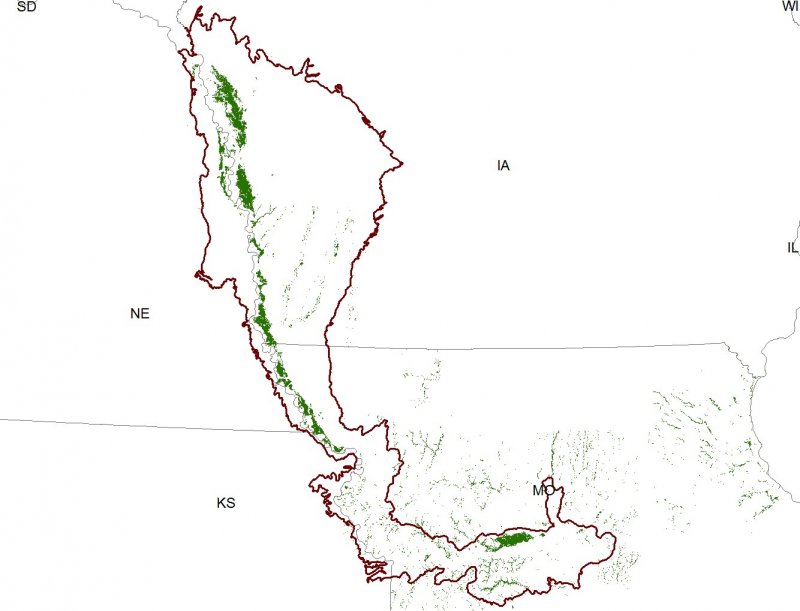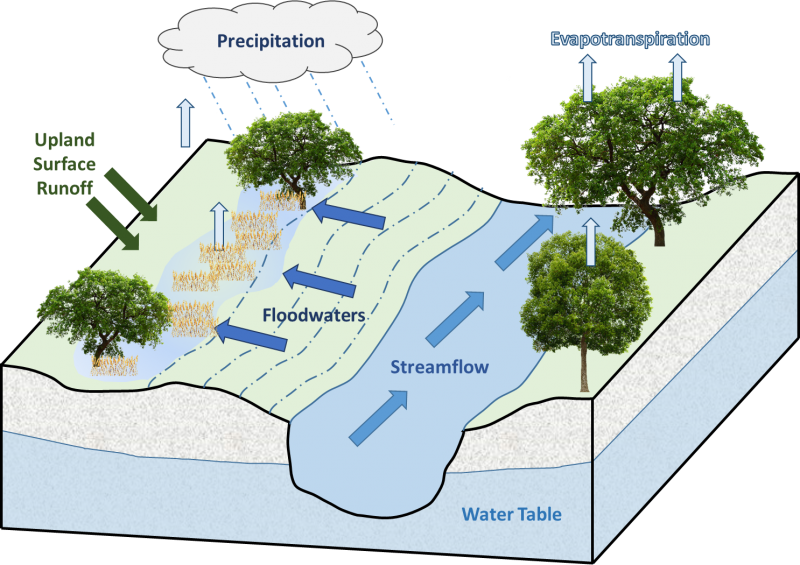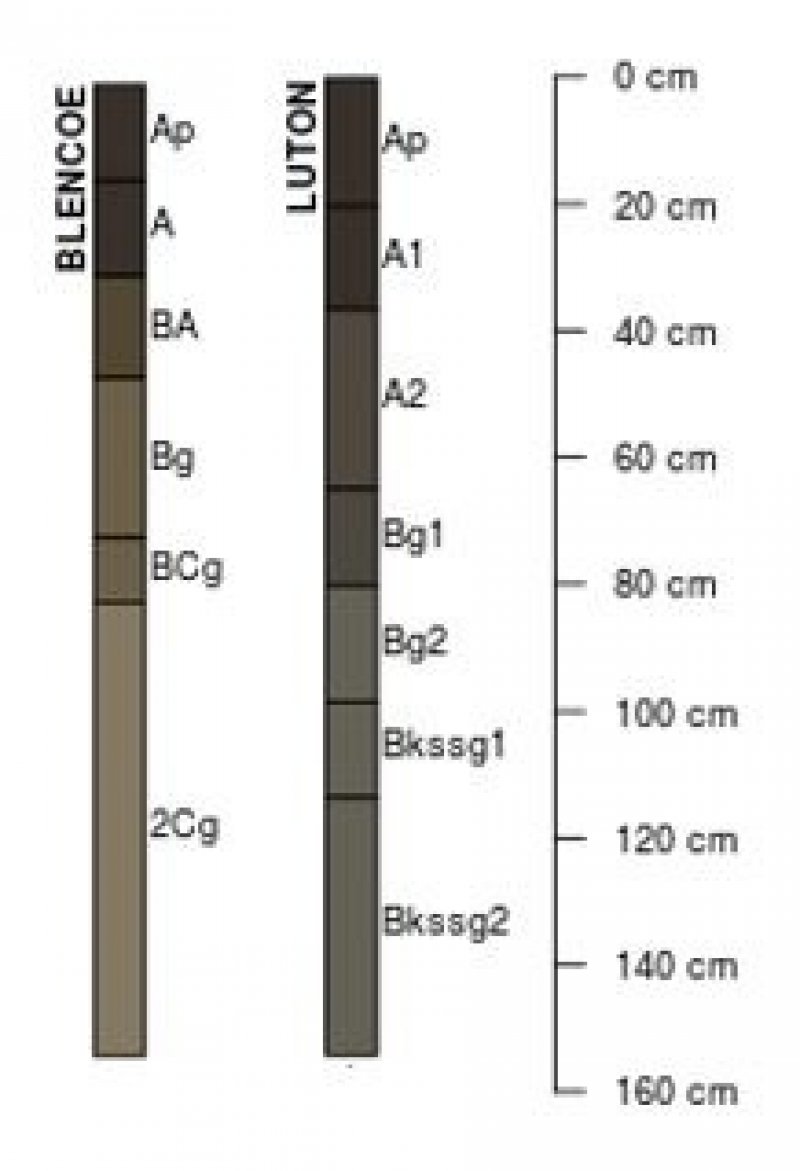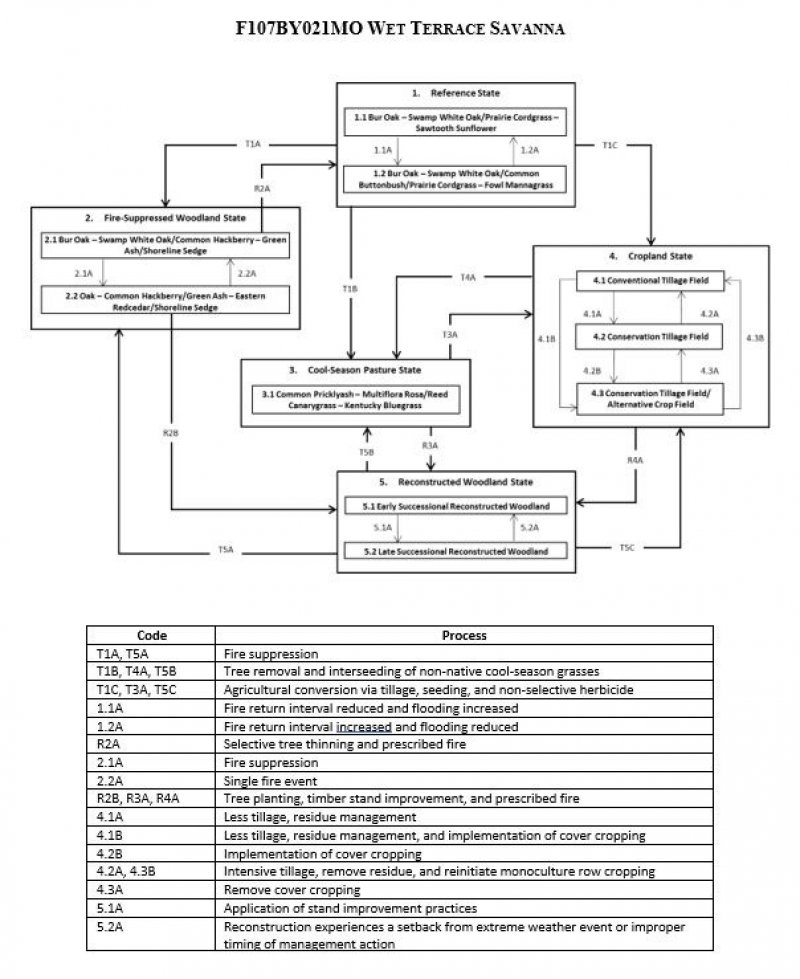Ecological dynamics
The Loess Hills region lies within the transition zone between the eastern deciduous forests and the Great Plains, with the Missouri River flowing through the middle. The heterogeneous topography of the area results in variable microclimates and fuel matrices that in turn are able to support prairies, savannas, woodlands, and forests (Nelson 2010). Wet Terrace Savannas form an aspect of this vegetative continuum. This ecological site occurs on stream terraces on somewhat poorly to poorly-drained alluvial soils. Species characteristic of this ecological site consist of upland and hydrophytic woody and herbaceous species (Nelson 2010; Steinauer and Rolfsmeier 2010).
Fire and flooding are the dominant disturbance factors in Wet Terrace Savannas. The significant presence of oaks in the community indicate the importance of fire as a natural process to maintain the site, but fire return intervals are currently unknown. Historically, seasonal backwater flooding of shallow depths (less than 36 inches) occurred every two to five years and could last for more than a month. Flooding occurred in fall, winter, and spring (Nelson 2010).
Today, many Wet Terrace Savannas have been reduced as a result of drainage and clearing for crop production and, to a smaller extent, livestock grazing. Long-term fire suppression has allowed the canopy to close and species composition to shift from a savanna to a woodland. Sites have also been degraded by stream channelization and levee construction which alters the hydrologic flood cycles and, ultimately, the reference plant community (Nelson 2010). Invasive species, such as eastern redcedar (Juniperus virginiana L.) have been invading this site and reducing native species diversity (LANDFIRE 2009).
State 1
Reference State
The reference plant community is categorized as a wet-mesic bottomland oak woodland. The two community phases within the reference state are dependent on seasonal flooding regimes and infrequent fires. The amount of water occurring at flood stages and fire intensity affects species composition, cover, and extent. Windthrow events and pest outbreaks have more localized impacts in the reference phases, but do contribute to overall plant community composition, diversity, cover, and productivity.
Community 1.1
Bur oak - Swamp White Oak / Prairie Cordgrass - Sawtooth Sunflower
Sites in this reference community represent an open-canopy (five to twenty percent cover) savanna with a reduced flood regime. Bur oak and swamp white oak are the dominant tree species for this reference community phase, but white oak (Quercus alba L.), common hackberry (Celtis occidentalis L.) and American elm (Ulmus americana L.) can also occur to a smaller extent (Nelson 2010; NatureServe 2015). Tree heights are generally between 60 and 90 feet tall and tree size class is medium (9 to 21 inches DBH) (LANDFIRE 2009; Nelson 2010). Periodic fires maintain the open-canopy structure. The understory is moderate, consisting mainly of tall- and mid-grasses, sedges, and perennial forbs. Prairie cordgrass is the dominant grass, and sawtooth sunflower is characteristic of this phase. Swamp verbena (Verbena hastata L.) and giant ironweed (Vernonia gigantea (Walter) Trel.) are common forbs that may be encountered (Nelson 2010).
Community 1.2
Bur oak - Swamp White Oak / Common Buttonbush / Prairie Cordgrass - Fowl Mannagrass
This reference community phase can occur following a prolonged fire-free interval that allows the canopy to close, as well as an increased flood regime. Bur oak and swamp white oak are still the dominant tree species, and the canopy has closed (twenty to sixty percent). Common buttonbush (Cephalanthus occidentalis L.) becomes an important shrub component, while the understory shifts to more shade- and flood-tolerant species including an increase in prairie cordgrass, fowl mannagrass (Glyceria striata (Lam.) Hitchc.), and various sedges (Carex L.) (NatureServe 2015).
Pathway P1.1A
Community 1.1 to 1.2
– Natural succession as a result of a prolonged, flood and/or fire-free period.
Pathway P1.2A
Community 1.2 to 1.1
Natural succession as a result of a prolonged, fire-free period and decreased flood regime.
State 2
Fire Suppressed Woodland State
Periodic fire maintained a moderate tree canopy and an understory more reminiscent of a wet prairie. However, the past 150 years of fire suppression efforts have transitioned the reference oak savanna community into a closed-canopy woodland state. Along with fire suppression, the channelization of streams and rivers and the development of reservoirs has also contributed to a closing of the canopy as well as causing a significant shift in species composition. (Nelson 2010; NatureServe 2015).
Community 2.1
Bur Oak – Swamp White Oak/Common Hackberry – Green Ash/Shoreline Sedge
This community phase represents a shift in plant community composition as a result of human-induced fire suppression. Mature bur oak and swamp white oak are the dominant overstory species, while common hackberry and green ash (Fraxinus pennsylvanica Marshall) increase in the subcanopy (NatureServe 2015). As the canopy beings to close (more than 60 percent cover), the understory becomes comprised by more shade-tolerant species such as shoreline sedge (Carex hyalinolepis Steud.) (Nelson 2010).
Community 2.2
Oak – Common Hackberry /Green Ash – Eastern Redcedar /Shoreline Sedge
Sites in this community phase are further impacted by lack of fire and flooding. Common hackberry becomes co-dominant with the mature bur oak and swamp white oak overstory. Green ash continues to remain a subcanopy component, and the extended absence of flooding and fire has allowed eastern redcedar to invade the site (LANDFIRE 2009). Canopy coverage increases to between 60 and 80 percent.
Pathway P2.1A
Community 2.1 to 2.2
Continued fire suppression and altered hydrologic regime.
Pathway P2.2A
Community 2.2 to 2.1
Single fire event.
State 3
Cool Season Pasture State
The cool-season pasture state occurs when the reference state has been anthropogenically-altered for livestock production. Early settlers harvested the trees for timber and fuel and seeded such non-native cool-season species as Kentucky bluegrass (Poa pratensis L.), converting the woodland to pasture (Smith 1998; IDNR 2013). Over time, as lands were continually grazed by large herds of cattle, the non-native species were able to spread and expand across the site, reducing the native species diversity. However, these sites are difficult to maintain due to frequent flooding and low available water capacity.
Community 3.1
Common Pricklyash – Multiflora Rose/Reed Canarygrass – Kentucky Bluegrass
Sites in this community phase arise from selective tree removal and seeding of non-native cool-season grasses (Steinauer and Rolfsmeier 2010). Elm, oak, ash, and hackberry all have some timber value and were harvested to supply the timber market for early settlers. Tree regeneration may occur for some time, but livestock can trample and eat tree seedlings thereby reducing the overstory. Unpalatable woody species, such as common pricklyash (Zanthoxylum americanum Mill.) and multiflora rose (Rosa multiflora Thunb.), can invade under excessive grazing (Randall and Herring 2012). Reed canarygrass (Phalaris arundinacea L.) and Kentucky bluegrass were common species used for pasture planting.
State 4
Cropland State
The Midwest is well-known for its highly-productive agricultural soils, and as a result, much of the MLRA has been converted to cropland, including portions of this ecological site. The continuous use of tillage, row-crop planting, and chemicals (i.e., herbicides, fertilizers, etc.) have effectively eliminated the reference community and many of its natural ecological functions in favor of crop production. Corn (Zea mays L.) and soybeans (Glycine max (L.) Merr.) are the dominant crops for the site. These areas are likely to remain in crop production for the foreseeable future.
Community 4.1
Conventional Tillage Field
Sites in this community phase typically consist of monoculture row-cropping maintained by conventional tillage practices. They are cropped in either continuous corn or corn-soybean rotations. The frequent use of deep tillage, low crop diversity, and bare soil conditions during the non-growing season negatively impact soil health. Under these practices, soil aggregation is reduced or destroyed, soil organic matter is reduced, erosion and runoff are increased, and infiltration is decreased, which can ultimately lead to undesirable changes in the hydrology of the watershed (Tomer et al. 2005).
Community 4.2
Conservation Tillage Field
This community phase is characterized by rotational crop production that utilizes various conservation tillage methods to promote soil health and reduce erosion. Conservation tillage methods include strip-till, ridge-till, vertical-till, or no-till planting systems. Strip-till keeps seedbed preparation to narrow bands less than one-third the width of the row where crop residue and soil consolidation are left undisturbed in-between seedbed areas. Strip-till planting may be completed in the fall and nutrient application either occurs simultaneously or at the time of planting. Ridge-till uses specialized equipment to create ridges in the seedbed and vegetative residue is left on the surface in between the ridges. Weeds are controlled with herbicides and/or cultivation, seedbed ridges are rebuilt during cultivation, and soils are left undisturbed from harvest to planting. Vertical-till systems employ machinery that lightly tills the soil and cuts up crop residue, mixing some of the residue into the top few inches of the soil while leaving a large portion on the surface. No-till management is the most conservative, disturbing soils only at the time of planting and fertilizer application. Compared to conventional tillage system, conservation tillage methods can reduce soil erosion, increase organic matter and water availability, improve water quality, and reduce soil compaction.
Community 4.3
Conservation Tillage Field/Alternative Crop Field
This condition applies conservation tillage methods as described above as well as adds cover crop practices. Cover crops typically include nitrogen-fixing species (e.g., legumes), small grains (e.g., rye, wheat, oats), or forage covers (e.g., turnips, radishes, rapeseed). The addition of cover crops not only adds plant diversity but also promotes soil health by reducing soil erosion, limiting nitrogen leaching, suppressing weeds, increasing soil organic matter, and improving the overall soil. In the case of small grain cover crops, surface cover and water infiltration are increased, while forage covers can be used to graze livestock or support local wildlife. Of the three community phases for this state, this phase promotes the greatest soil sustainability and improves ecological functioning within a cropland system.
Pathway P4.1A
Community 4.1 to 4.2
Tillage operations are greatly reduced, crop rotation occurs on a regular schedule, and crop residue is allowed to remain on the soil surface.
Pathway P4.1B
Community 4.1 to 4.3
Tillage operations are greatly reduced or eliminated, crop rotation is either reduced or eliminated, and crop residue is allowed to remain on the soil surface, and cover crops are implemented to prevent soil erosion.
Pathway P4.2A
Community 4.2 to 4.1
– Intensive tillage is utilized and monoculture row-cropping is established.
Pathway P4.2B
Community 4.2 to 4.3
Cover crops are implemented to prevent soil erosion.
Pathway P4.3B
Community 4.3 to 4.1
Intensive tillage is utilized, cover crops practices are abandoned, monoculture row-cropping is established, and crop rotation is reduced or eliminated.
Pathway P4.3A
Community 4.3 to 4.2
Cover crop practices are abandoned.
State 5
Reconstructed Savanna State
The combination of natural and anthropogenic disturbances occurring today has resulted in a number of ecosystem health issues, and restoration back to the historic reference condition is likely not possible. Many natural lowland communities are being stressed by non-native diseases and pests, habitat fragmentation, permanent changes in hydrologic regimes, fire suppression, and overabundant deer populations on top of naturally-occurring disturbances (severe weather and native pests) (Flickinger 2010; Nelson 2010). However, these habitats provide multiple ecosystem services including carbon sequestration; clean air and water; soil conservation; biodiversity support; as well as a variety of cultural activities (e.g., hiking, hunting) (Millennium Ecosystem Assessment 2005; Flickinger 2010). Therefore, conservation of lowland savannas should still be pursued. Habitat reconstructions are an important tool for repairing natural ecological functioning and providing habitat protection for numerous species of Wet Terrace Savannas. Therefore ecological restoration should aim to aid the recovery of degraded, damaged, or destroyed ecosystems. A successful restoration will have the ability to structurally and functionally sustain itself, demonstrate resilience to the ranges of stress and disturbance, and create and maintain positive biotic and abiotic interactions (SER 2002). The reconstructed savanna state is the result of a long-term commitment involving a multi-step, adaptive management process.
Community 5.1
Early Successional Reconstructed Savanna
This community phase represents the early community assembly from savanna reconstruction. It is highly dependent on the current condition of the site based on past and current land management actions, invasive species, and proximity to land populated with non-native pests and diseases. Therefore, no two sites will have the same early successional composition. Technical forestry assistance should be sought to develop suitable stewardship management plans.
Community 5.2
Late Successional Reconstructed Savanna
Appropriately timed management practices (e.g., prescribed fire, hazardous fuels management, forest stand improvement, continuing integrated pest management) applied to the early successional community phase can help increase the stand maturity, pushing the site into a late successional community phase over time. A late successional reconstructed savanna will have an uneven-aged, semi-closed canopy and a well-developed understory.
Pathway P5.1A
Community 5.1 to 5.2
Application of stand improvement practices in line with a developed management plan.
Pathway P5.2A
Community 5.2 to 5.1
Reconstruction experiences a setback from extreme weather event or improper timing of management actions.
Transition T1A
State 1 to 2
Fire suppression and hydrologic alterations transition this site to the fire-suppressed woodland state (2).
Transition T1B
State 1 to 3
Woody species reduction, interseeding of non-native, cool-season grasses, and continuous grazing transition this site to the cool-season pasture state (3).
Transition T1C
State 1 to 4
Installation of drain tiles, tillage, seeding of agricultural crops, and non-selective herbicide transition this site to the cropland state (4).
Restoration pathway R2A
State 2 to 1
Selective tree thinning and prescribed fire is used to restore this site to the reference state (1).
Restoration pathway R2B
State 2 to 5
Site preparation, invasive species control (native and non-native), tree planting, and prescribed fire transition this site to the reconstructed savanna state (5).
Transition T3A
State 3 to 4
Installation of drain tiles, tillage, seeding of agricultural crops, and non-selective herbicide transition this site to the cropland state (4).
Restoration pathway R3A
State 3 to 5
Site preparation, invasive species control (native and non-native), tree planting, and prescribed fire transition this site to the reconstructed savanna state (5).
Restoration pathway T4A
State 4 to 3
Non-selective herbicide, seeding of non-native cool-season grasses, and continuous grazing transitions the site to the cool-season pasture state (3).
Restoration pathway R4A
State 4 to 5
Site preparation, invasive species control (native and non-native), tree planting, and prescribed fire transition this site to the reconstructed savanna state (5).
Transition T5A
State 5 to 2
Fire (or fire surrogate) suppression efforts transition this site to the fire-suppressed forest state (2).
Restoration pathway T5B
State 5 to 3
Tree removal and interseeding non-native cool-season grasses transition this site to the cool-season pasture state (3).
Transition T5C
State 5 to 4
Tillage, seeding of agricultural crops, and non-selective herbicide transition this site to the cropland state (4).





